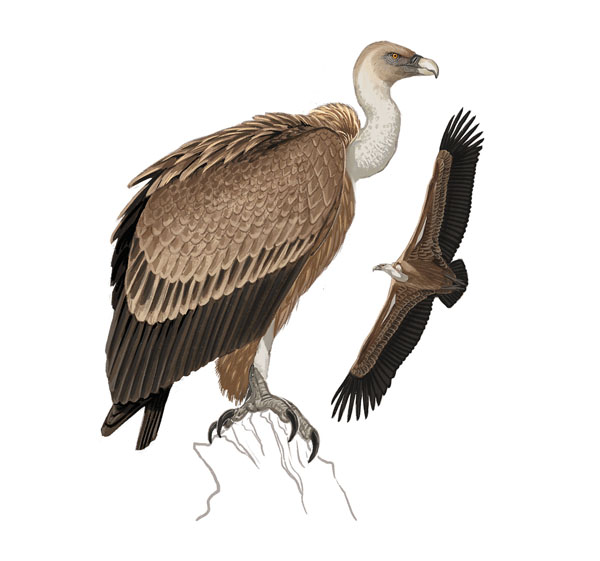Gyps fulvus
IUCN
LCBasic Information
Scientific classification
- name:Gyps fulvus
- Scientific Name:vulture, mountain eagle
- Outline:Raptor
- Family:Accipitriformes Accipitridae Gyps
Vital signs
- length:95-120cm
- Weight:8-11kg
- lifetime:30-40 year
Feature
Nature's Cleaner
Distribution and Habitat
The distribution range is very wide, throughout Europe, the Middle East and North Africa, and also in India and the Himalayas. It is most common in the Mediterranean coastal countries, with the largest number in Spain, which accounts for three-quarters of the European number. It lives at altitudes up to 2,500 meters, occasionally up to 3,000 meters in northeastern India. The vulture habitat is wide, open and rocky mountains and plateaus, grasslands, scrubland and semi-deserts. It usually hovers in warm climates and can tolerate harsh conditions such as cold, rain, mist and even snow to obtain particularly favorable foraging or breeding conditions. It tends to avoid forests, wetlands, lakes and sea surfaces.
Appearance
It is a large scavenging bird of prey with a body length of 120cm. It has a long and narrow neck, with the feathers on the head and neck degenerated and bare, a floppy nearly white ruff at the base of the neck, and a yellowish-white head and neck. The body and upper wing feathers are light brown, in sharp contrast to the black feathers on the rest of the wings and tail. This contrast is particularly evident in the juveniles, which have particularly pale upper wing feathers. The flight feathers and short, square tail feathers are dark brown-black. The underside is covered with brown stripes. The body feathers are brown-brown, the flight feathers and tail feathers are dark brown, the head and neck are bare with white down, the lower neck has a white collar, and the underparts are brown-black with light vertical stripes. It is more brown than similar species of Alpine Vulture. The beak is strong and powerful, light yellow, and the feet are gray.
Details
Vultures are birds of the genus Griffon, family Accipitridae. Vultures usually hover in warm climates and can endure harsh conditions such as cold, rain, mist and even snow to obtain particularly favorable conditions for foraging or breeding. They tend to avoid forests, wetlands, lakes and sea surfaces. With their long and wide wings, they can soar in the sky for hours and have excellent vision. Vultures are nature's scavengers and usually feed on the soft tissues of medium to large mammal carcasses. They forage over large areas and clearly search for animal carcasses on the ground. They gather in groups of 15-20 pairs, sometimes as many as 150 pairs. They are accustomed to sticking their heads into the abdominal cavity of animal carcasses and pecking at the internal organs and muscles. Vultures do not have strong feet and sharp claws. They rely on their keen sense of smell to find rotting animal carcasses and often fight over a piece of meat. Before the strong vultures with sharp beaks tear the skin of the animal remains, the smaller vultures with weak beaks can only wait.

The largest adult reportedly weighed up to 15 kg and was probably bred in captivity. It hatches featherless and is typical of Old World vultures, with a very white head, very broad wings, and short feathers on the tail. Its neck is white and its bill is yellow. The body is yellow with dark flight feathers on the wings.








